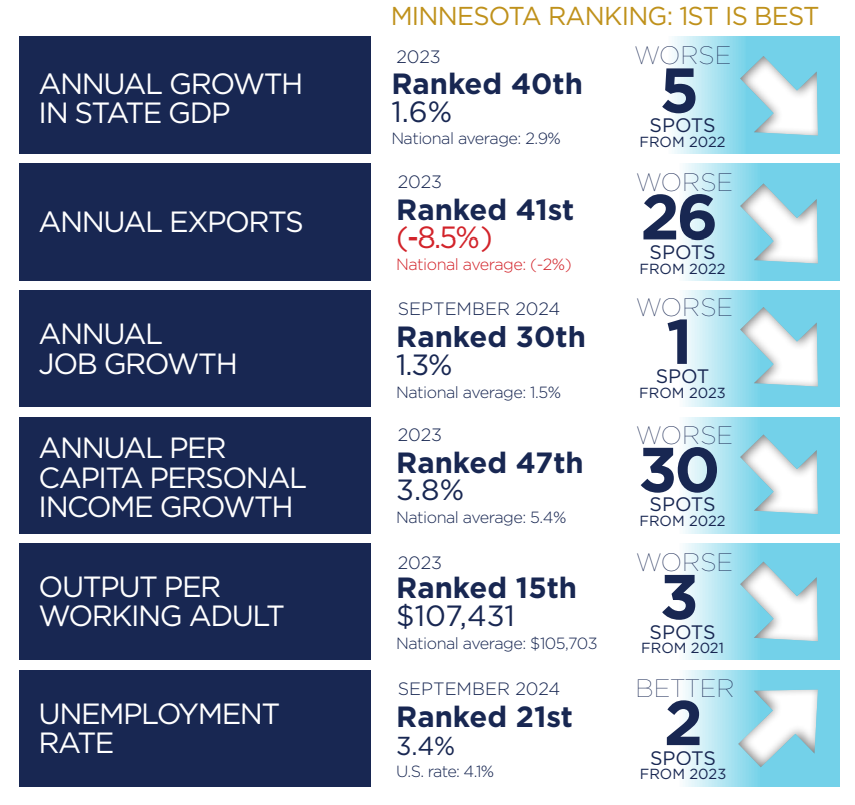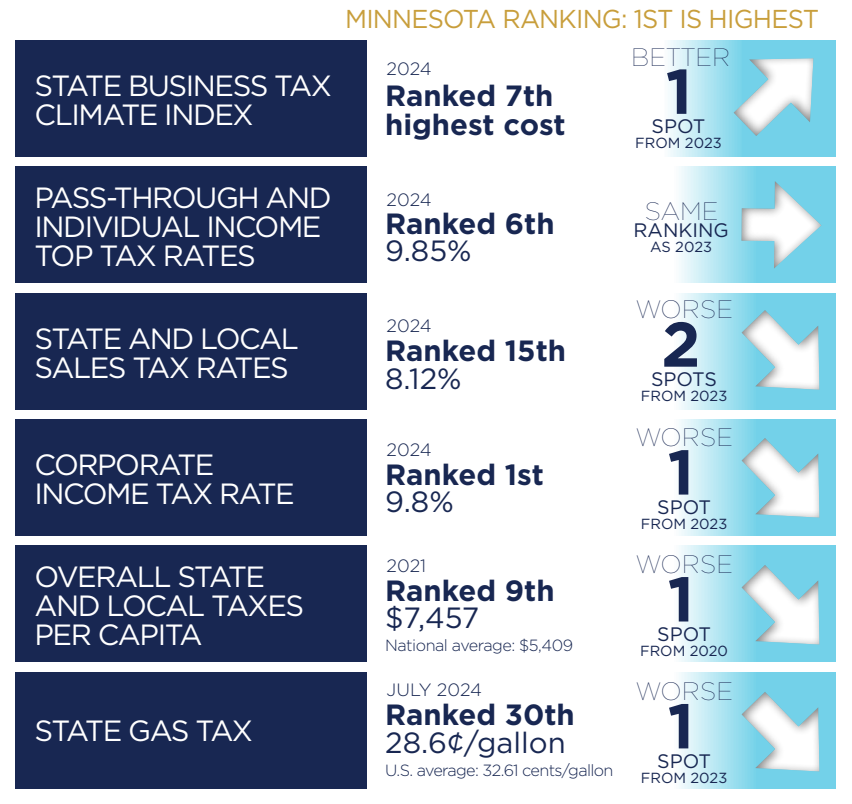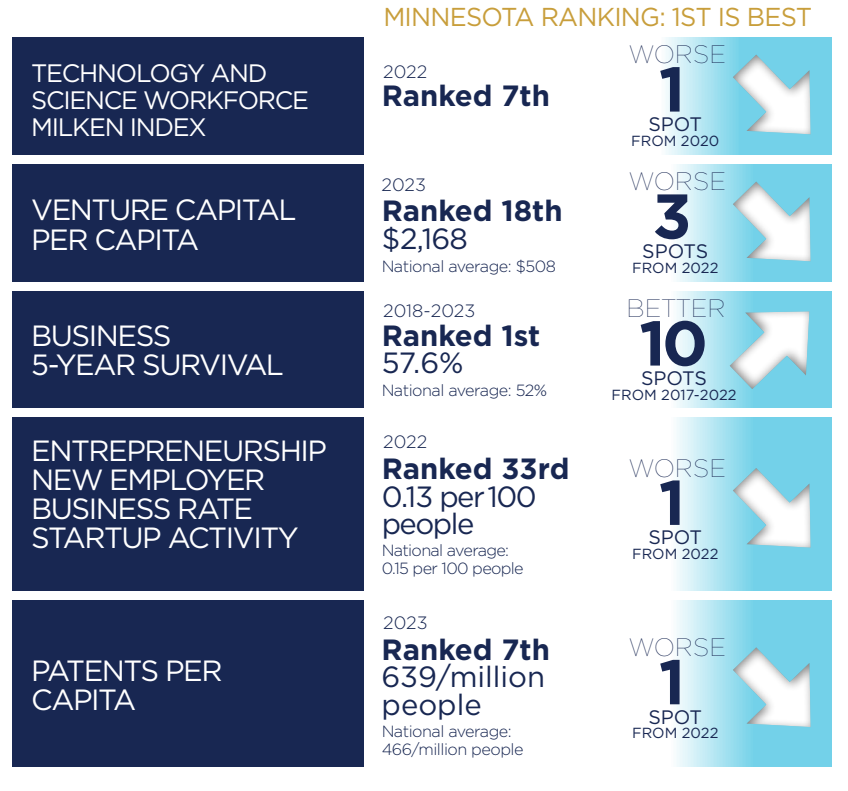2025 Business Benchmarks report
For the last ten years, the Business Benchmarks report has laid out economic indicators in several categories that best determine a healthy economy and a competitive business climate. Our state has numerous economic strengths including a diverse industry base with businesses of all sizes, a legacy of innovation, hardworking labor force and great natural amenities. When asked why they choose to stay in Minnesota, a strong majority of business leaders say it is because their business was established here. We must honor that legacy and improve our comparative position so businesses can continue to start, grow and thrive in Minnesota.
In this tenth annual report, we look back on a decade of data and talk to business executives throughout the state, and a longer-term view comes into focus. What does an economy need to thrive?
Determinants of a healthy economy:
- Strong GDP and job growth
- Costs conducive to private sector investment, expansion
- Sensible business regulations
- Near-and long-term workforce strategy
- Smart public sector investments that spur growth
Strong GDP and job growth
A strong Gross Domestic Product (GDP) means an economy is expanding. It reflects increased production, rising incomes, higher consumer spending, expanded business and increased private sector investment. These elements together can expand the tax base without tax increases and increase the standard of living for citizens. 
Individual businesses benefit from higher GDP through improved business confidence and increased consumer demand. Greater access to capital spurs innovation and growth. A stronger labor market gives businesses a larger pool of skilled workers, thanks to increased employment and training opportunities. Business leaders cite GDP growth as a top measurement of creating success. For them, it leads to new investments in their business and their employees.
Job growth is another key indicator of economic health as it signals business expansion, improved financial position for individuals and overall resiliency.
In the first Business Benchmarks report, Minnesota’s GDP ranked 13th in the nation at 2.4%. Today, it ranks 40th at 1.6%. Each state has experienced ups and downs during that time and it’s a complicated set of circumstances that determine relative growth. Job growth has largely remained stagnant since the first report; ranked 30th then and 31st today (1.4% in both years). Over the past decade, Minnesota’s economy expanded at a slower rate than the U.S. economy. GDP growth averaged 2.4% annually in the U.S., compared to just 1.7% in Minnesota. While this differential may not seem stark in the short-term, the long run implications are more significant. At this rate, it would take Minnesota’s economy 41.5 years to double in size from 2023 levels, a full twelve years longer than it would take the U.S. economy to double, leaving future Minnesotans at a relative disadvantage.
Costs should be conducive to investment, expansion
The cost of doing business can have an impact on numerous elements of a state’s economic strength. Business executives cite high costs as the most important issue for elected officials to address. In a recent poll, reducing taxes, bringing down costs and reducing government spending accounted for 60% of overall responses. Lower business costs increase profitability and wages, encourage investment and create jobs, and spur innovation and entrepreneurship. Low costs can continue this trend and lead to growth.
Minnesota’s tax rates have hovered in the top 10 highest nationally for more than a decade. In the 2023 legislative session alone, lawmakers drained a more than $18 billion surplus and increased taxes by more than $10 billion. Meanwhile, 29 other states have lowered their tax rates, making Minnesota even more of an outlier.
These increases coupled with increased costs of doing business discourage growth and impact specific industries disproportionately high, including manufacturers and small businesses. Business leaders have taken note: When asked if they plan to stay and grow in Minnesota or look elsewhere, those who say they are growing or moving their business out of the state due to high taxes have increased by 10% over the last year, now at 77%. And 71% of business leaders say that state taxes are a greater burden on their business than they were just five years ago.
Sensible business regulations
Sensible regulations can ensure accountability, uphold environmental standards and protect consumers. But overregulation increases business uncertainty and costs, and compliance burdens, and it stifles innovation. Balance is necessary to protect public interest and promote economic growth.
In the last two years, the number of mandates placed on business have burdened them with increased costs (such as payroll taxes) and the cost of staff time spent on compliance. Small-and medium-sized businesses are disproportionately impacted, as they have less budgetary flexibility and their time could instead be spent innovating, growing to compete and investing in their workforce.
Employers are already realizing the impact of the escalating number of workplace mandates. The paid leave mandate alone will raise payroll taxes by .88% and will continue to increase administrative burdens when it is fully implemented in 2026. Executives now list government regulations as the second biggest “barrier to business” in Minnesota.
Near-and long-term workforce strategy
Minnesota’s skilled workforce is often noted as a key component of business success. Our labor participation rate consistently ranks in the top 10 in the nation, which leads to job creation, supports growth and enhances quality of life. But that is a near-term strength and the data show concerns for the long-term. 
Net domestic migration - the change in population moving into and out of our state - has ranked in the lower third in the nation for more than a decade. According to the State Demographer, by the late 2040s, any population growth the state experiences will be from migration instead of natural growth (birth versus deaths). Although Minnesota benefits from international migration, we have lost domestic migration for most of the last 20 years. In the 1990s, the state gained an average of 9,600 people from other states yearly. That trend reversed in the early 2000s when the state began registering net losses. In this year’s report, Minnesota is also ranked 35th in the nation, with a net loss of 4,686. Bringing and retaining our workforce is critical for our long-term success.
Educating our next generation of employees is another critical aspect of closing the workforce gap.
Unfortunately, Minnesota’s test scores have declined faster than the national average, with 40% of fourth graders not reading at a basic level. In 2013, Minnesota ranked above the national average, but that strength has since eroded. Today we tie the national average but rank 25th in the nation. Minnesota must regain its historic strength of a robust, highly skilled workforce.
Smart investments that spur growth
Minnesota has a strong record of supporting long-term investment strategies that help businesses grow over time. Business executives cite the need for public investments that support growth, including Research and Development (R&D) opportunities and enabling access to capital.
One standout example is our state’s comprehensive transportation system. It boasts major ports and waterways, railways, an award-winning international airport and an interconnected road system. Increased investments have helped the state’s competitiveness overall.
Public policy plays a role in competitiveness
Minnesota’s lawmakers have a responsibility to understand the impact of their decisions on employers, employees and the state’s economy. The policies that they support can either stimulate or stifle growth and competitiveness and will impact how many people live here, start and grow a business here and our shared economic success for generations. We encourage the business community and elected officials to build a better understanding of how employers contribute to our economy and the quality of life in Minnesota.
Economy: Steady but slow to grow

Taxes: Occupying the top spots in the nation

Cost of doing business: Increases impacting competitiveness

Innovation: A strong legacy and critical for the future

Infrastructure: Continued success

Workforce: Near-term gains with future hurdles

Questions about the 2025 Business Benchmarks report?
We'd love to hear from you! If you have questions on this year's Business Benchmarks or would like to get involved on the topics listed above, please contact us or reach out to one of our expert staff.

